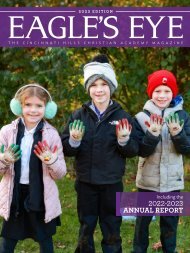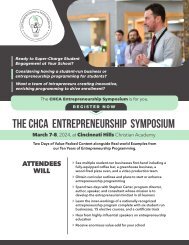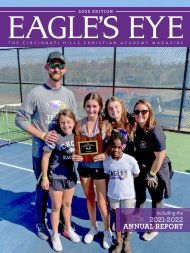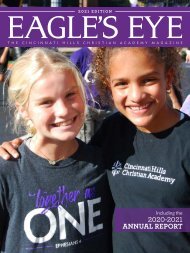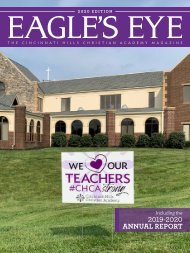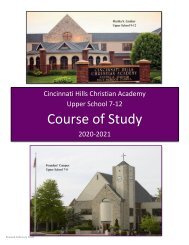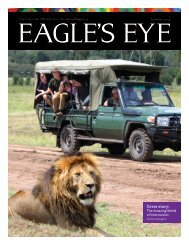Mission, Vision, Competencies, Standards, and Benchmarks
A Statement of Curriculum CINCINNATI HILLS CHRISTIAN ACADEMY Edyth B. Lindner Campus Otto Armleder Memorial Education Center Founders’ Campus Martha S. Lindner Campus 2019 Edition
A Statement of Curriculum
CINCINNATI HILLS CHRISTIAN ACADEMY
Edyth B. Lindner Campus
Otto Armleder Memorial Education Center
Founders’ Campus
Martha S. Lindner Campus
2019 Edition
You also want an ePaper? Increase the reach of your titles
YUMPU automatically turns print PDFs into web optimized ePapers that Google loves.
‣ Describe collisions of objects as elastic or inelastic. Know that energy <strong>and</strong> momentum<br />
are conserved in elastic collisions, but only momentum is conserved in inelastic<br />
collisions.<br />
‣ Classify all the various forms of energy as either kinetic or potential.<br />
‣ Explain how energy may change form or be redistributed but the total quantity of<br />
energy is conserved.<br />
‣ Demonstrate that waves such as light, (e.g., sound, seismic, <strong>and</strong> water have energy<br />
<strong>and</strong> that waves can transfer energy when they interact with matter.<br />
‣ Apply the measureable properties of waves, such as wavelength, frequency, velocity,<br />
<strong>and</strong> amplitude, to describe mathematically the properties of materials, such as the<br />
index of refraction, reflectivity, diffraction patterns.<br />
‣ Calculate the wavelength of a wave as a function of the relative motion of the source<br />
<strong>and</strong> the observer.<br />
‣ Explain how Doppler Effect applies to the current underst<strong>and</strong>ing of the<br />
universe, redshift.<br />
‣ Summarize the historical development of scientific theories <strong>and</strong> ideas within the study<br />
of physical sciences.<br />
Life Science<br />
‣ Describe the composition, diversity, complexity, <strong>and</strong> interconnectedness of life<br />
on Earth.<br />
‣ Apply classification systems to describe the vast diversity of organisms <strong>and</strong> their<br />
degree of relatedness between them.<br />
‣ Apply fundamental concepts of heredity <strong>and</strong> evolution to underst<strong>and</strong> the living world,<br />
the physical environment, <strong>and</strong> the interactions within <strong>and</strong> between them.<br />
‣ Explain that cells are the basic unit of structure <strong>and</strong> function of living organisms, that<br />
once life originated all cells come from pre-existing cells, <strong>and</strong> there are a variety of<br />
cell types.<br />
‣ Know that all cells: (a) are covered by a cell membrane that controls which materials<br />
can enter/leave the cell, (b) are composed of a small number of chemical elements—<br />
mainly carbon, but also hydrogen, nitrogen, oxygen, phosphorus, <strong>and</strong> sulfur.<br />
‣ Describe the structure, function, <strong>and</strong> interrelatedness of cell organelles.<br />
‣ Underst<strong>and</strong> that the cell is a system that conducts a variety of functions associated<br />
with life as materials enter <strong>and</strong> leave the cell through the cell membrane.<br />
‣ Explain the characteristics of life as regulated by cellular processes, such as<br />
photosynthesis, chemosynthesis, cellular respiration, <strong>and</strong> describe the process of cell<br />
division <strong>and</strong> differentiation.<br />
‣ Relate the chemical basis of life to heredity, genetics, diversity, species survival, adapt<br />
ations, <strong>and</strong> extinction.<br />
‣ Describe the mechanisms for biological evolution such as natural selection, genetic<br />
drift, immigration, emigration <strong>and</strong> mutation.<br />
‣ Relate the diversity of species to the theory of evolution, <strong>and</strong> the kinship between<br />
organisms or species to the similarity in their DNA sequences.<br />
‣ Know <strong>and</strong> apply the structure <strong>and</strong> function of DNA <strong>and</strong> RNA in cells to explain the gen<br />
etic mechanisms for cellular genetics, inheritance, <strong>and</strong> gene mutations. Students will<br />
know that:<br />
o genetic information is coded in DNA molecules, passed from parents to<br />
offspring, <strong>and</strong> provides instructions for assembling protein molecules;<br />
o<br />
o<br />
the genetic code is virtually the same for all life forms;<br />
genes are segments of DNA molecules which can be altered via insertions,<br />
deletions, or substitutions of DNA segments.<br />
Back to Table of Contents





